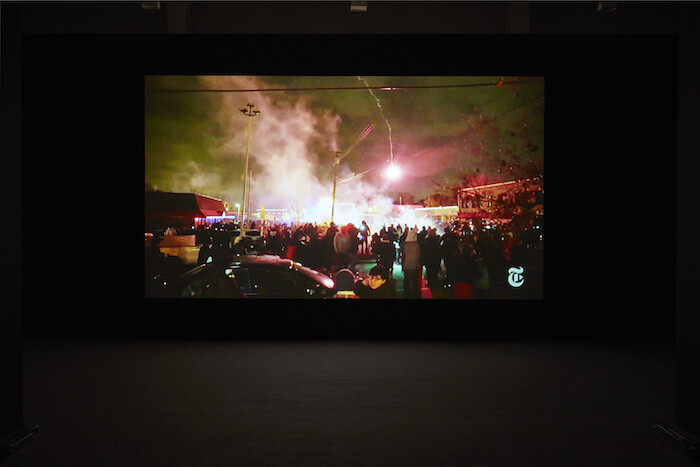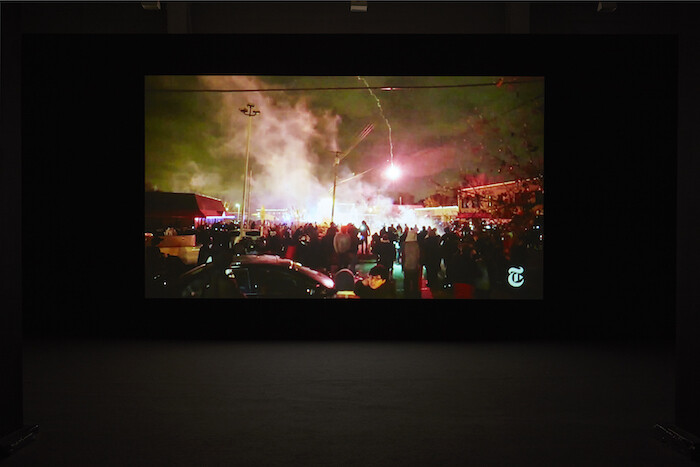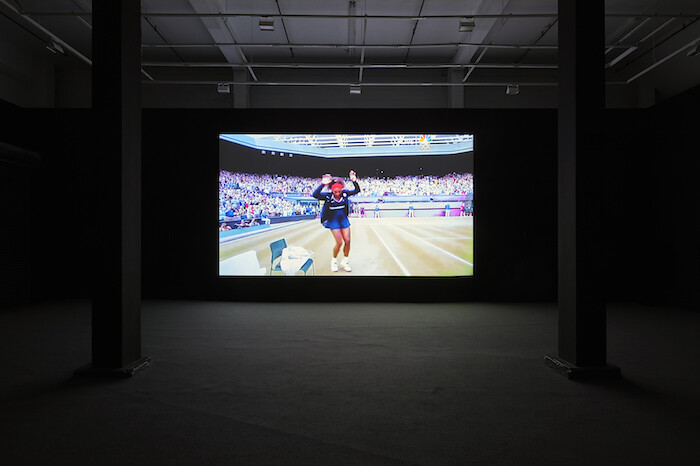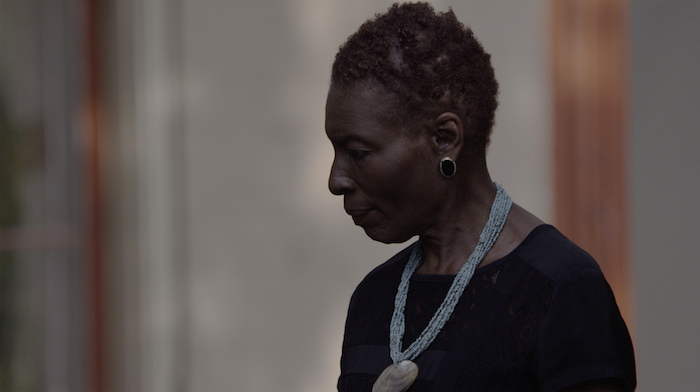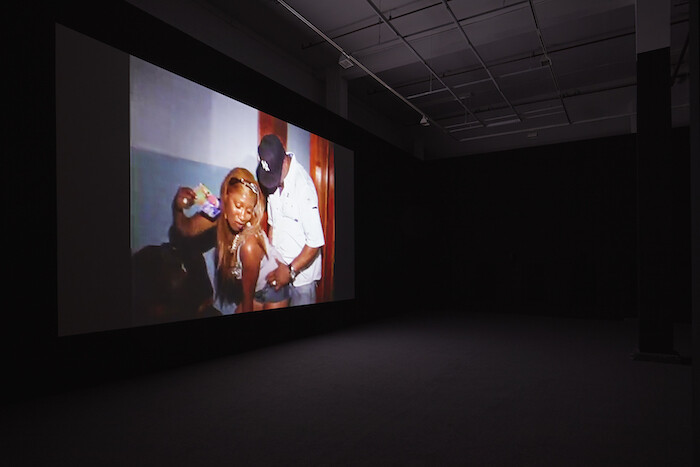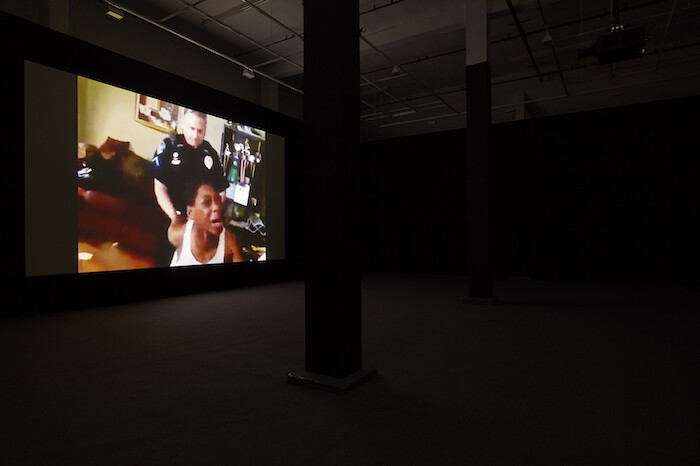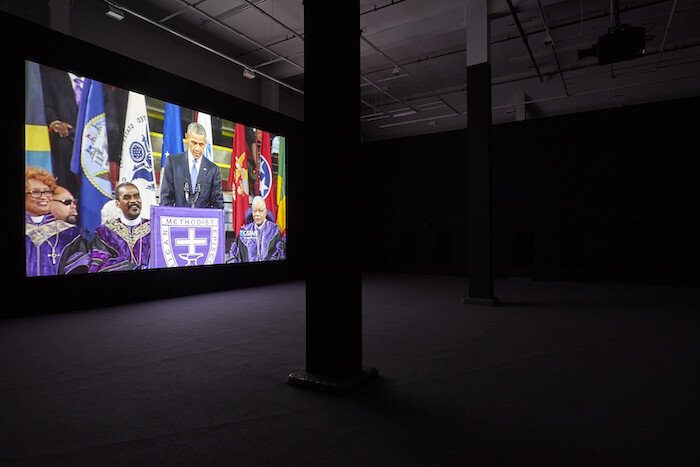The art world is overstuffed with collages of YouTube clips and Internet artifacts, with most of these trafficking in an ironic glibness that is overly praised either for its affect or lack of it. Though cut from the same digital cloth, the compilation video Love Is The Message, The Message Is Death (2016) comes from a radically different place. Appropriately situated in Gavin Brown Enterprise’s new location in the historic black (and rapidly gentrifying) neighborhood of Harlem, this monumental piece is the sole work on view in the cavernous, converted brewery. Jafa doesn’t allow his materials—a collection of black athletes, musicians, dancers, civil rights leaders, victims of police violence, and sci-fi creatures—to overwhelm him; instead he moves with them, feeling a pulse in and through each fleet and purposeful cut.
This makes the work emphatically cinematic. Jafa, a long-time cinematographer whose career includes Julie Dash’s newly restored Daughters of the Dust (1991) and two recent music videos for Solange Knowles (“Don’t Touch My Hair” and “Cranes In The Sky,” both 2016), has developed a complex system of continuity that goes far beyond classical Hollywood cinema norms. Instead, he adapts a musical structure of harmony, rhythm, and variation, as when a shot of a man kicked by police cuts to another one falling backwards in a dance, creating a smooth, unbroken motion. In sequences like this, Jafa blends Sergei Eisenstein’s dynamic approach to montage with the improvisational foundations of so much black music, from jazz to hip-hop. Love Is The Message… was made under the imprimatur of TNEG, a film studio Jafa created with Elissa Blount Moorhead and Malik Sayeed, where he has been laboring to create a black cinema equivalent to the “power, beauty, and alienation of black music.”1
What would such a cinema look like? Surely it would not be Ava DuVernay’s recent film 13th (2016), that, for all its concern with the state of black life in contemporary America, relegates music to the background, as if it were somehow less serious or political than its array of talking heads. Rather, for Jafa, culture is itself the stuff of black life, what is produced by it, and what sustains it. He once said about Oscar Michaud’s formal choices in his films: “once is an accident, twice is coincidence, the third time is culture.” Black existence has been this way too, enduring the many attempts to snuff it out, even as its culture was embraced by its oppressors. In every image and in every cut, Love Is The Message… asserts that black life is black aesthetics. This for Jafa is more than an expression of black vitality, but itself a way of moving through, and sometimes beyond, the world.
Correspondingly, Love Is The Message… steps with history, even dances with it. Instead of organizing the footage chronologically, Jafa cuts to movement, all the while stressing continuity across context, matching the passing of a joint between jazz musicians to, a few shots later, a deft behind-the-back assist by Stephen Curry. Some linkages are more elliptical, like when a cell phone video of a man singing “I been dreamin’, I been dreamin’” is matched with a shot of Martin Luther King, Jr. waving from a convertible. Jafa draws from multiple sources, some high-res, others bearing the familiar Getty Images watermark. Many more come from YouTube, including a devastating shot of a tearful black boy holding his hands up against a wall, with the voice of a man, perhaps his father, sternly warning “that’s what the police do to you.” For Jafa, social media is not some shallow mirror of narcissistic fantasy, but a way of marking a record, if not for present survival, then for a future that will shake its head at this troubled time.
The gallery setting for Love Is The Message… is appropriately bare, empty even of benches. Visitors lean against the two columns painted black, or sit on the floor, small before the screen that stretches from floor to ceiling. It wouldn’t be unreasonable to lie down, like Kanye West did in his Saturday Night Live performance of “Ultralight Beam” (2016). Here, the song plays on speakers hung around the gallery walls, so that the viewer is positioned as if within the belly of its gospel choir. Ultralight Beam builds in stages, sometimes breaking to watch a teenage Notorious B.I.G. freestyle on a Bed-Stuy corner, or to hear a woman’s wailing fear as she’s searched by highway patrol. Famously, when President Obama delivered a eulogy for Reverend Clementa Pinckney in Charleston, he paused to consider what key in which to sing “Amazing Grace.” In Love Is The Message…, his deliberate baritone—notably tinged with a blue note, as if to signal the blackness he was finally claiming—meets Kanye’s choir in perfect harmony, another moment absorbed into this immense song.
Such moments are already part of its structure, with searching solos that emerge from, then fall back into a densely layered chorus. Woven together, these elements become more than accident or coincidence, but a culture born of what Jafa has described as the “common misery [that] both defines and limits who we are.”2 Perhaps this collective experience is why there are so many images of people helping one another, from a couple holding each other in waist-high Katrina floodwaters to, from the 1992 Olympics, a pained and limping Derek Redmond aided by his father to the finish line. In this and many instances, victory is mingled with defeat. Jafa’s great achievement is to create a structure that cradles these connections between black life and black culture, and that opens to their beauty and suffering, bursting like flares from a roiling sun.
TNEG frequently uses this line to describe itself, as here: http://creativetime.org/summit/speakers/arthur-jafa-elissa-blount-moorhead/
Arthur Jafa, On the Blackness of Blacknuss: My Black Death (New York: Publication Studio Hudson, 2015), 18.
